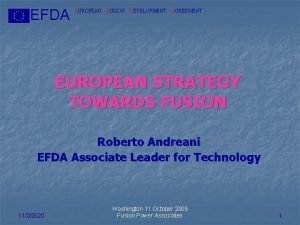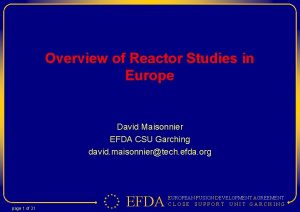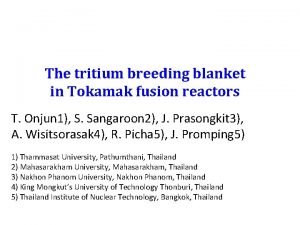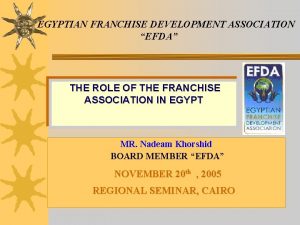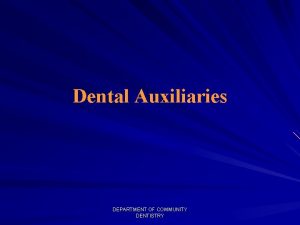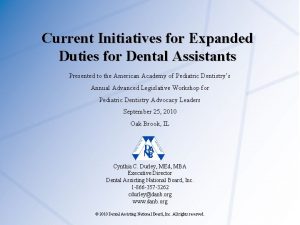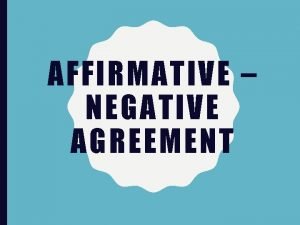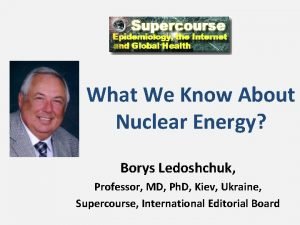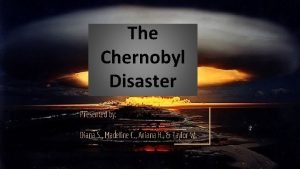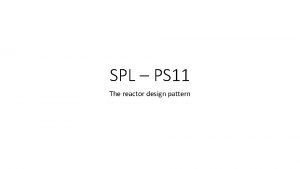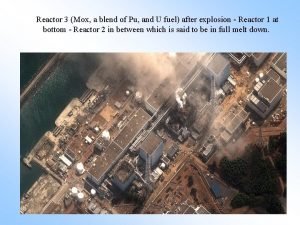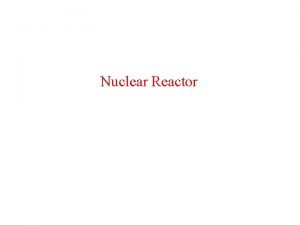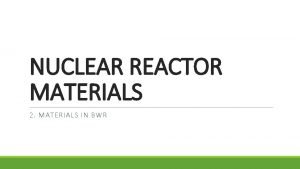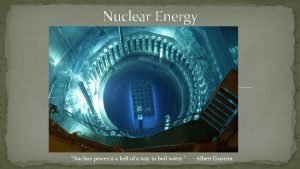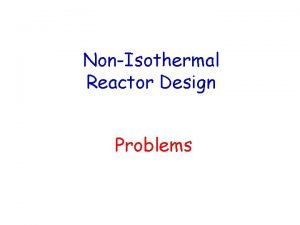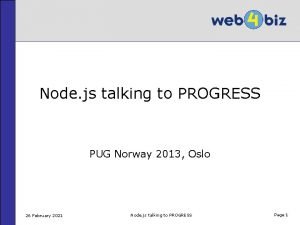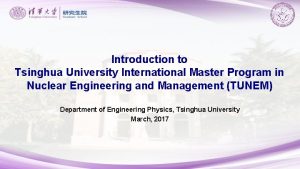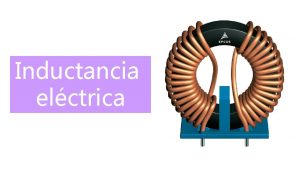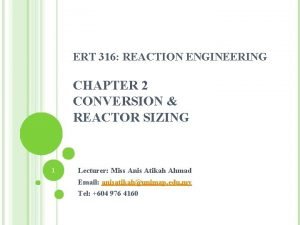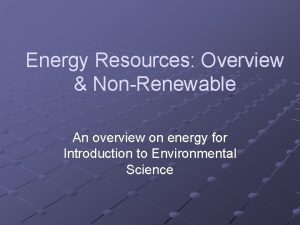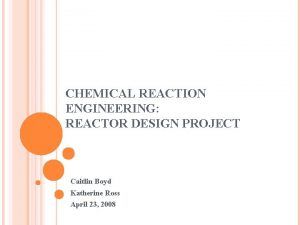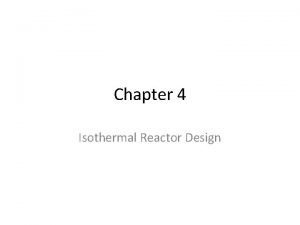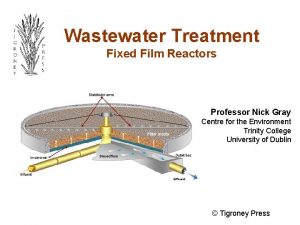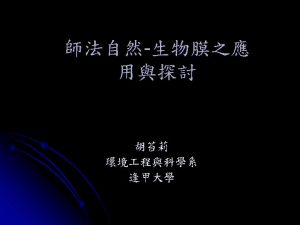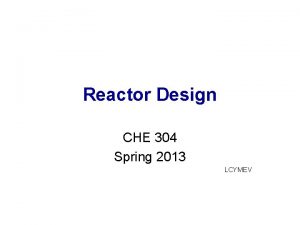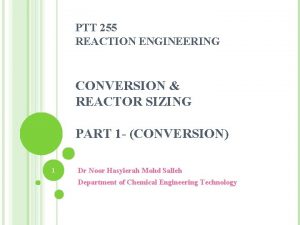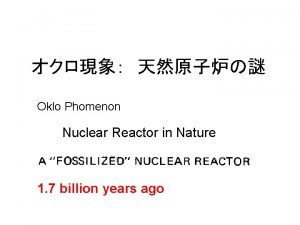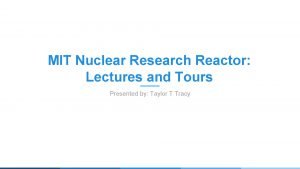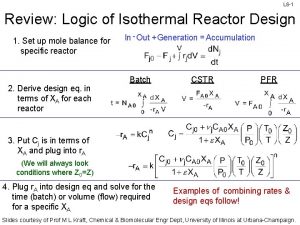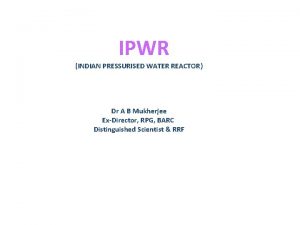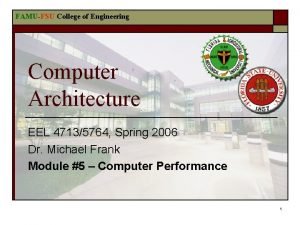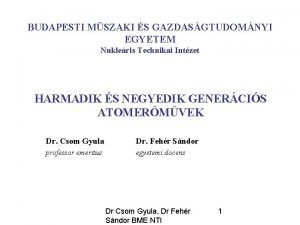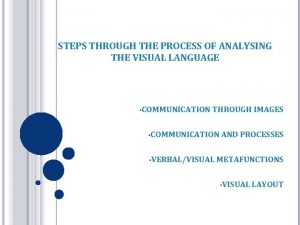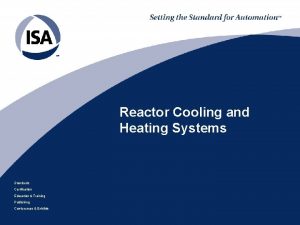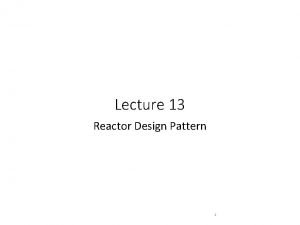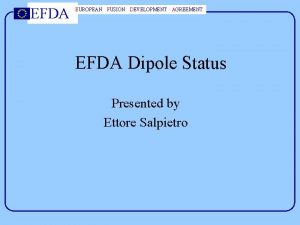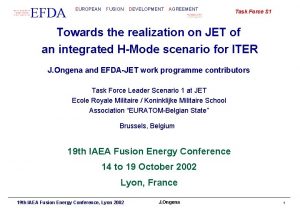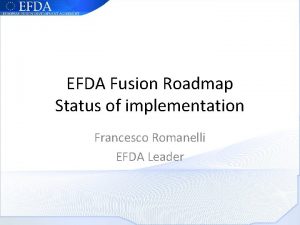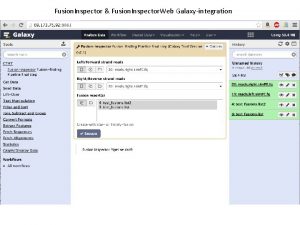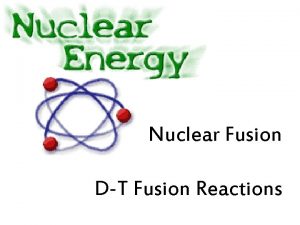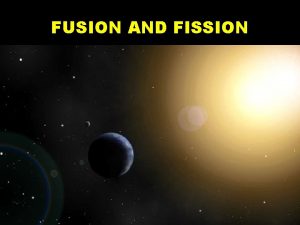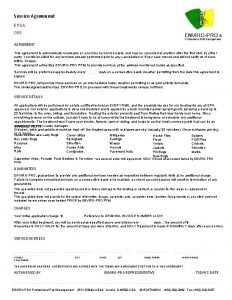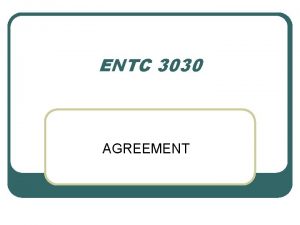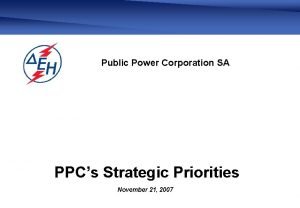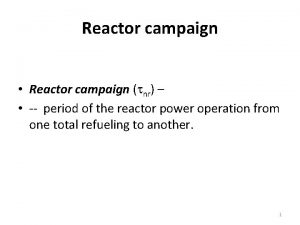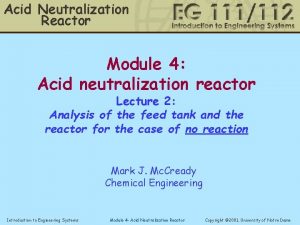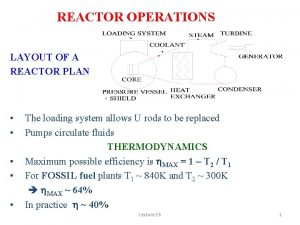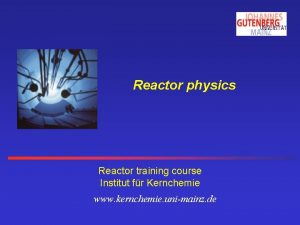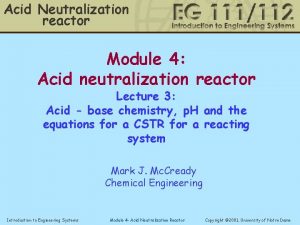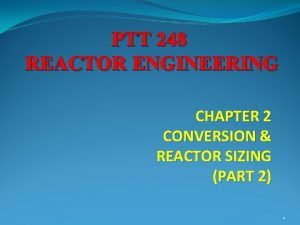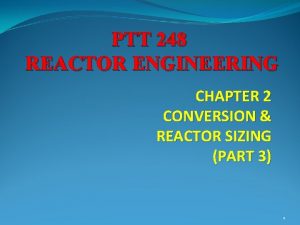EFDA EUROPEAN FUSION DEVELOPMENT AGREEMENT PPCS Reactor Models









































- Slides: 41

EFDA EUROPEAN FUSION DEVELOPMENT AGREEMENT PPCS Reactor Models 9 th Course on Technology of Fusion Tokamak Reactors International School of Fusion Reactor Technology - 2004 David Maisonnier EFDA CSU Garching (david. maisonnier@tech. efda. org) 9 th Course on Technology of Fusion Tokamak Reactors 26 July 2004 PPCS Reactor Models, page 1/41 D. Maisonnier

EFDA EUROPEAN FUSION DEVELOPMENT AGREEMENT Overview Fusion Tokamak Reactors: WHY ? PPCS Reactor Models Key issues for DEMO/Reactors Conclusion 9 th Course on Technology of Fusion Tokamak Reactors 26 July 2004 PPCS Reactor Models, page 2/41 D. Maisonnier

EFDA EUROPEAN FUSION DEVELOPMENT AGREEMENT Tokamak Fusion Reactors WHY ? 9 th Course on Technology of Fusion Tokamak Reactors 26 July 2004 PPCS Reactor Models, page 3/41 D. Maisonnier

EFDA EUROPEAN FUSION DEVELOPMENT AGREEMENT Fusion Machines Different magnetic configurations are possible: tokamaks, stellarators, reversed field pinches and spherical tokamaks. Tokamaks have been the most successful machines up to now. The largest fusion machines built to date are tokamaks (JET, JT 60, TFTR), the next step machine (ITER) will be a tokamak and most reactor studies assume a tokamak configuration. 9 th Course on Technology of Fusion Tokamak Reactors 26 July 2004 PPCS Reactor Models, page 4/41 D. Maisonnier

EFDA EUROPEAN FUSION DEVELOPMENT AGREEMENT Tokamak Success Story = W /P ~I ×R E ITER E th P LOSS 2 JET Cross section of present EU D-shape tokamaks compared to the ITER project 9 th Course on Technology of Fusion Tokamak Reactors 26 July 2004 PPCS Reactor Models, page 5/41 D. Maisonnier

EFDA EUROPEAN FUSION DEVELOPMENT AGREEMENT Fusion Reactors - Principle 2 + T 3 → He 4 + n 1 D 1 1 2 0 3. 5 Me. V heating of plasma 14. 1 Me. V T production, heat for electricity generation mass-energy balance D (2 - 0. 000 994)×mp + T (3 - 0. 006 284)×mp → α + (4 - 0. 027 404)×mp n (1 + 0. 001 378)×mp mp = 1. 6726 × 10 -27 kg E = Δm × c 2 = 0. 018 75 × mp × c 2 = 2. 818 × 10 -12 joules = 17. 6 Me. V 9 Course on Technology of Fusion Tokamak Reactors th 26 July 2004 PPCS Reactor Models, page 6/41 D. Maisonnier

EFDA EUROPEAN FUSION DEVELOPMENT AGREEMENT Fusion Reaction: D + T 2 + T 3 → He 4 + n 1 + 17. 6 Me. V D 1 1 2 0 cross-section of fusion reactions He 3 + n 1 + 3. 27 Me. V D 2 + D 2 → T 3 + H 1 + 4. 03 Me. V D 2 + He 3 → He 4 + H 1 + 18. 3 Me. V ℛ (reaction rate) = σ × ni × vi × N σ has he dimension of a surface Hot plasma, n = n 1 + n 2 , max. for n 1 = n 2 9 th Course on Technology of Fusion Tokamak Reactors 26 July 2004 PPCS Reactor Models, page 7/41 D. Maisonnier

EFDA EUROPEAN FUSION DEVELOPMENT AGREEMENT Why Fusion Energy ? Ü The world will not run out of fossil fuels during the 21 st century. Ü Fusion is a clean source of energy (no green-house gases, no rad-waste requiring geological repository). CO 2. ppt Ü Fusion is a safe source of energy (e. g. no evacuation). Ü Fusion fuels are available for everybody (energy independence). Fusion. Fuel. ppt Ü The above features are essential to achieve social acceptability. Ü Moreover, the development of the “hydrogen economy” requires abundant primary sources of energy. Fusion could be one of them. Socio-Economics GC. Tosato 9 th Course on Technology of Fusion Tokamak Reactors 26 July 2004 PPCS Reactor Models, page 8/41 D. Maisonnier

EFDA EUROPEAN FUSION DEVELOPMENT AGREEMENT PPCS Reactor Models 9 th Course on Technology of Fusion Tokamak Reactors 26 July 2004 PPCS Reactor Models, page 9/41 D. Maisonnier

EFDA EUROPEAN FUSION DEVELOPMENT AGREEMENT Towards a Fusion Reactor ITER - - ? - - FOAK Reactor -- Reactors “Broader Approach” • Next Step Machine (e. g. ITER) • Satellite tokamaks (physics) • Technology R&D (e. g. IFMIF) Qualification of components and processes To demonstrate the scientific and technological feasibility of fusion energy for peaceful purposes 9 th Course on Technology of Fusion Tokamak Reactors 26 July 2004 • High availability • Safe and environmentalfriendly • Economically acceptable PPCS Reactor Models, page 10/41 D. Maisonnier

EFDA EUROPEAN FUSION DEVELOPMENT AGREEMENT Towards a Fusion Reactor (cont’d) Considering that: Ü European Fusion programme is reactor oriented Ü ITER (next step machine) objectives clearly defined Power Plant Conceptual Study It is necessary to: Ü Confirms that a first commercial fusion power plant will be economically acceptable, with major safety and environmental advantages Ü Clarify what devices should be built after ITER (roadmap) European PPCS 9 th Course on Technology of Fusion Tokamak Reactors 26 July 2004 C to assess the fusion energy status C to establish coherence and priorities in the EU fusion programme PPCS Reactor Models, page 11/41 D. Maisonnier

EFDA EUROPEAN FUSION DEVELOPMENT AGREEMENT Tokamak Reactor, layout Nuclear Power Core Blanket • T production • Heat recovery • Nuclear shielding Divertor • Ash (He) exhaust, with the associated power • Heat recovery (desirable) 9 th Course on Technology of Fusion Tokamak Reactors 26 July 2004 PPCS Reactor Models, page 12/41 D. Maisonnier

EFDA EUROPEAN FUSION DEVELOPMENT AGREEMENT Tokamak Reactor, layout (cont’d) Other Main Systems H & CD Injection of power into the plasma Remote Handling All maintenance inside the bioshield Magnet system Balance of Plant Tritium plant 9 th Course on Technology of Fusion Tokamak Reactors 26 July 2004 PPCS Reactor Models, page 13/41 D. Maisonnier

EFDA EUROPEAN FUSION DEVELOPMENT AGREEMENT Main Reactor Requirements* Ü Safety / Environment Ä no need for emergency evacuation, no active systems for safe shut-down, no structure melting following LOCA Ä minimum waste transport, minimum waste to repository; Ü Operation Ä steady state, ~ 1 GWe, base load; Ä availability 75 80 %, with only few unplanned shut-downs/year; Ü Economics Ä public acceptance could be even more important than economics Ä economic comparison among equally acceptable energy sources Ä licensing/regulation requirements strongly reduced vs. fission Ä construction time 5 years * Recommendations from EU utilities/industry 9 th Course on Technology of Fusion Tokamak Reactors 26 July 2004 PPCS Reactor Models, page 14/41 D. Maisonnier

EFDA EUROPEAN FUSION DEVELOPMENT AGREEMENT PPCS Models 4 plant models developed, ranging from “limited” to “very advanced” extrapolations in physics and technology, as examples of a spectrum of possibilities (e. g. 3 different coolants considered: water, helium and lithium-lead). Models selected considering EU blanket concepts development program (DEMO and long term). Systems code (PROCESS), subject to assigned plasma physics and technology rules and limits, determined the economic optimum for each model. Compared to earlier European studies, the plasma physics basis is updated and the designs aim to satisfy economic objectives 9 th Course on Technology of Fusion Tokamak Reactors 26 July 2004 PPCS Reactor Models, page 15/41 D. Maisonnier

EFDA EUROPEAN FUSION DEVELOPMENT AGREEMENT Plasma physics basis Ü Based on assessments made by expert panel appointed by European fusion programme. Ü Near term Models (A & B): modest improvement w. r. t. the design basis of ITER - monotonic q profile with q 95=3, within the following limits: HH<1. 2, n/n. GR<1. 2, βN<3. 5 and first stability region. Ü More advanced Models(C & D): progressive improvements in performance - high β and high confinement, MHD stabilisation (strong shaping), high bootstrap current fraction and divertor protection. Physics C. Kessel System studies D. Ward 9 th Course on Technology of Fusion Tokamak Reactors 26 July 2004 PPCS Reactor Models, page 16/41 D. Maisonnier

EFDA EUROPEAN FUSION DEVELOPMENT Fusion Reactors PPCS Parameters Parameter AGREEMENT Model A Model B Model C Model D Unit Size (GWe) 1. 5 1. 3 1. 4 1. 5 Fusion Power (GW) 5. 0 3. 6 3. 4 2. 5 0. 31/0. 33 0. 36 0. 41 0. 60 Major Radius (m) 9. 55 8. 6 7. 5 6. 1 Plasma Current (MA) 30. 5 28. 0 20. 1 14. 1 Bootstrap Fraction 0. 45 0. 43 0. 63 0. 76 Padd (MW) 246 270 112 71 Recirculating power fraction 0. 28 0. 27 0. 13 0. 11 Divertor Peak load (MW/m-2) 15 10 10 5 Av. neutron wall load 2. 2 2. 0 2. 2 2. 4 Net efficiency 9 th Course on Technology of Fusion Tokamak Reactors 26 July 2004 PPCS Reactor Models, page 17/41 D. Maisonnier

EFDA EUROPEAN FUSION DEVELOPMENT AGREEMENT Materials for Nuclear Power Core Blanket and Divertors L. Giancarli Divertor G. Janeschitz Materials A. Moeslang, B. Van der Schaaf 9 th Course on Technology of Fusion Tokamak Reactors 26 July 2004 PPCS Reactor Models, page 18/41 D. Maisonnier

EFDA EUROPEAN FUSION DEVELOPMENT AGREEMENT Typical Internal Components Water cooled divertor Helium-cooled pebble bed blanket 9 th Course on Technology of Fusion Tokamak Reactors 26 July 2004 PPCS Reactor Models, page 19/41 D. Maisonnier

EFDA EUROPEAN FUSION DEVELOPMENT AGREEMENT Key Technical Innovations helium-cooled divertor concept Concept permitting high tolerable heat flux of 10 MW/m 2 9 th Course on Technology of Fusion Tokamak Reactors 26 July 2004 PPCS Reactor Models, page 20/41 D. Maisonnier

EFDA EUROPEAN FUSION DEVELOPMENT AGREEMENT Key Technical Innovations maintenance Ü In-vessel scheduled maintenance driven by # of internal components, by parallel work and by logistics (# shifts, # working hours per shift, transport to hot cell during night shift). Ü Replacement time estimates for ITER (1998: 720 BM, 2001: 421 BM) # of internal components too high for an availability target of 75%. Ü Alternative segmentation in “large sectors” (ARIES) review by PPCS: severe engineering difficulties, availability 75 -80%, capital cost due to increased size increase >12. 5%. Large. Sector. ppt Ü PPCS investigated alternative segmentation of blanket in “large modules” without affecting the overall mechanical structure. 9 th Course on Technology of Fusion Tokamak Reactors 26 July 2004 PPCS Reactor Models, page 21/41 D. Maisonnier

EFDA EUROPEAN FUSION DEVELOPMENT AGREEMENT Handling of large modules Lifetime: blanket 5 yr. , divertor 2 yr. Estimates for models A (189 BM, 54 DC) and B (162 BM, 54 DC): Ü availability between 78 and 85 % (3 and 4 ports, BM and DC handled in series or in parallel) Ü include 4% for ex-vessel maintenance but exclude contingencies – at least 5% (PPCS: 10 th of a kind) 9 th Course on Technology of Fusion Tokamak Reactors 26 July 2004 PPCS Reactor Models, page 22/41 D. Maisonnier

EUROPEAN FUSION DEVELOPMENT AGREEMENT Fusion Reactors Plant Layout EFDA Most of the plant is conventional, not fusion specific! Bo. P E. Bogusch 9 th Course on Technology of Fusion Tokamak Reactors 26 July 2004 PPCS Reactor Models, page 23/41 D. Maisonnier

EFDA EUROPEAN FUSION DEVELOPMENT AGREEMENT S&E Key Question Given that: Ü The designs satisfy economic objectives Ü The plasma physics basis is new (and so the parameters are substantially different than in earlier European studies) Do the good safety and environmental features still hold? 9 th Course on Technology of Fusion Tokamak Reactors 26 July 2004 PPCS Reactor Models, page 24/41 D. Maisonnier

EFDA EUROPEAN FUSION DEVELOPMENT AGREEMENT Fusion Reactors Safety & Environment Inherent features: low amount of fuel, reaction stops shortly after fuelling stops, low residual heat, no greenhouse gases, no fissile materials. Total loss of coolant: no melting, without relying on any active safety system. Doses to the public after most severe accident driven by in-plant energies (bounding accident): comparable to annual dose due to natural causes, no evacuation. Model A: 1. 2 m. Sv Model B: 18. 1 m. Sv Accident sequence analysis: much lower doses than for the bounding accident analyses. 9 th Course on Technology of Fusion Tokamak Reactors 26 July 2004 No need of deep geological disposal for rad-waste. PPCS Reactor Models, page 25/41 D. Maisonnier

EFDA EUROPEAN FUSION DEVELOPMENT AGREEMENT Fusion Reactors Cost of Electricity Internal cost of electricity, for the PPCS models, ranges from 3 to 9 Eurocents/k. Wh External cost ranges from 0. 06 to 0. 09 Eurocents/k. Wh Even the near-term Models are acceptably competitive Fusion PPCS 9 th Course on Technology of Fusion Tokamak Reactors 26 July 2004 PPCS Reactor Models, page 26/41 D. Maisonnier

EFDA EUROPEAN FUSION DEVELOPMENT AGREEMENT Key Issues PPCS conclusions Trade-offs between physics and technology Technology 9 th Course on Technology of Fusion Tokamak Reactors 26 July 2004 PPCS Reactor Models, page 27/41 D. Maisonnier

EFDA EUROPEAN FUSION DEVELOPMENT AGREEMENT PPCS Conclusions (technical) Ü Plasma performance only marginally better than the design basis of ITER is sufficient for economic viability (cost of electricity likely to be comparable with that from other environmentally responsible sources of electricity generation) Ü Definition of a maintenance concept capable of delivering high availability (75 %) Ü Conceptual design of a helium-cooled divertor capable of tolerating a peak heat load of 10 MW/m 2 9 th Course on Technology of Fusion Tokamak Reactors 26 July 2004 PPCS Reactor Models, page 28/41 D. Maisonnier

EFDA EUROPEAN FUSION DEVELOPMENT AGREEMENT PPCS Conclusions (S & E) Ü The PPCS models confirm the well-attested and attractive safety and environmental features of fusion: loss of cooling events: no melting of structures Ä most severe conceivable accident driven by in-plant energies: no evacuation Ä extremely rare (hypothetical) ultra-energetic ex-plant event: health effects smaller than the typical consequences of the external hazard itself Ä activated material from fusion power stations would not constitute a waste management burden for future generations Ä 9 th Course on Technology of Fusion Tokamak Reactors 26 July 2004 PPCS Reactor Models, page 29/41 D. Maisonnier

EFDA EUROPEAN FUSION DEVELOPMENT AGREEMENT PPCS Conclusions (R&D) Ü European fusion development programme on the right lines: next step machine (ITER) to demonstrate the scientific feasibility of fusion Ä materials development (low activation martensitic steels and tungsten alloys, more advanced materials) Ä development of “DEMO blanket models” Ä Ü More work on: the development of divertor systems (high heat flux tolerance, high temperature operation, adequate lifetime) Ä development and qualification of maintenance procedures (availability requirements of power plants) Ä 9 th Course on Technology of Fusion Tokamak Reactors 26 July 2004 PPCS Reactor Models, page 30/41 D. Maisonnier

EFDA EUROPEAN FUSION DEVELOPMENT AGREEMENT Towards a Fusion Reactor Next Step - - DEMO ? -- - FOAK Reactor -- Reactors scientific and technological feasibility of fusion energy Qualification of components and processes • High availability • Safe and environmentalfriendly • Economically acceptable 9 th Course on Technology of Fusion Tokamak Reactors 26 July 2004 PPCS Reactor Models, page 31/41 D. Maisonnier

EFDA EUROPEAN FUSION DEVELOPMENT AGREEMENT Physics vs. Technology A complete understanding of the physics is the main objective of the next-step (ITER and satellite tokamaks) Amongst the possible operating scenarios, trade-offs between physics and technology will allow to determine the optimum scenario Question: if and how to address some of these questions in ITER 9 th Course on Technology of Fusion Tokamak Reactors 26 July 2004 PPCS Reactor Models, page 32/41 D. Maisonnier

EFDA EUROPEAN FUSION DEVELOPMENT AGREEMENT Physics vs. Technology (PWI) PWI G. Federici Impurities radiative power losses, fuel dilution Impurities originate from (1) erosion of plasma facing materials (physical sputtering, evaporation), (2) desorbtion of species trapped in the plasma facing materials, (3) He ashes ITER DEMO first wall: W learn to operate tokamaks with a W first wall. ITER objective ? ITER: start operations with a W first wall or foresee complete replacement of FW ? 9 th Course on Technology of Fusion Tokamak Reactors 26 July 2004 PPCS Reactor Models, page 33/41 D. Maisonnier

EFDA EUROPEAN FUSION DEVELOPMENT AGREEMENT Physics vs. Technology (I ) P Hypothesis: no disruptions in a reactor, but licensing authorities will require confinement to be guaranteed following the most severe conceivable accident driven by in-plant energies ASME III class II (off normal) III (10 -4/yr) IV (10 -6/yr) Design criteria Sm 1. 2×Sm EM loads: a major driver for the design of in-vessel components EM loads scale with dimensions of component, IP and B Number of in-vessel components to be minimised to reduce replacement time (major cause of plant unavailability) ITER: 421 modules, typically 1× 1. 5 m 2, IP = 15 MA, Bo = 5. 3 T PPCS: 180 “large” modules, 2× 4 m 2, IP = 30 MA, Bo = 7 T (models A and B) 9 th Course on Technology of Fusion Tokamak Reactors 26 July 2004 PPCS Reactor Models, page 34/41 D. Maisonnier

EFDA EUROPEAN FUSION DEVELOPMENT AGREEMENT Physics vs. Technology (I , cont’d) P Additional power must be minimised (IP = IBOOT + ICD) Maximise bootstrap current Ä Minimise power for current drive: minimise ICD, maximise efficiency of CD systems (PCD, el = PCD/ηCD) (models A and B: ηCD=60%, models A and B: ηCD=70%) Ä Minimise IP But E ~ IP × R 2, n ~ IP Remember ultimate goal: produce electricity, i. e. Q > 10 and acceptable recirculating power fraction ITER: develop reactor relevant scenarios Physicists and Engineers: talk to each other! 9 th Course on Technology of Fusion Tokamak Reactors 26 July 2004 PPCS Reactor Models, page 35/41 D. Maisonnier

EFDA EUROPEAN FUSION DEVELOPMENT AGREEMENT Technology Items to be qualified prior to to building DEMO / FOAK reactor: Ü Materials Ü Systems and components (concept and design) for high availability 9 th Course on Technology of Fusion Tokamak Reactors 26 July 2004 PPCS Reactor Models, page 36/41 D. Maisonnier

EFDA EUROPEAN FUSION DEVELOPMENT AGREEMENT Technology (materials) EUROFER (150 dpa, 550ºC) Structural material W alloy Armour material model A Not good enough for a He-cooled reactor (THe, out > 650 ºC) EUROFER ODS Structural material W alloy Structural (> 850 ºC) and Armour materials model B Reliability Simplicity (Ideally) one coolant only Safety do not mix water cooling and Be in the reactor He-cooled device requires a He-cooled divertor major challenge Bo. P for He-cooled device not available large industrial development (initially) low reliability How credible is a He-cooled DEMO concept ? 9 th Course on Technology of Fusion Tokamak Reactors 26 July 2004 PPCS Reactor Models, page 37/41 D. Maisonnier

EFDA EUROPEAN FUSION DEVELOPMENT AGREEMENT Technology (reliability) H&CD systems high efficiency (>60%) and high reliability Reliability Simplicity high temperature superconductors for magnets (power densities severely limits the interest of B higher than in PPCS) Reliability use qualified components and systems all FOAK reactor components and systems to be qualified in DEMO Qualify in-vessel maintenance procedures target for scheduled operations, incl. contingency: > 80% availability Ex-vessel maintenance in parallel with scheduled in-vessel maintenance Target for unscheduled maintenance: < 5% Continue investigations on in-vessel maintenance procedures Think seriously about ex-vessel maintenance (also in ITER) 9 th Course on Technology of Fusion Tokamak Reactors 26 July 2004 PPCS Reactor Models, page 38/41 D. Maisonnier

EFDA EUROPEAN FUSION DEVELOPMENT AGREEMENT Conclusions 9 th Course on Technology of Fusion Tokamak Reactors 26 July 2004 PPCS Reactor Models, page 39/41 D. Maisonnier

EFDA EUROPEAN FUSION DEVELOPMENT AGREEMENT PPCS Fusion Reactors (summary) Ü Why fusion? A potentially safe and clean source of energy Ü PPCS models (examples of a spectrum of possibilities) Confirm S&E attractiveness of fusion Ü Issues Physics vs. technology: PWI, IP Ä Technology: materials (EUROFER, W alloys), coolant for DEMO, availability (maintenance procedures, simple and proven concepts for components) Ä 9 th Course on Technology of Fusion Tokamak Reactors 26 July 2004 PPCS Reactor Models, page 40/41 D. Maisonnier

EFDA EUROPEAN FUSION DEVELOPMENT AGREEMENT PPCS Fusion Reactors (future) Was PPCS successful ? Ü It confirmed the S&E attractiveness of fusion Ü The analysis are robust: conclusions true for all models, clearly insensitive to limited variations of key parameters Ü Study completed, no “further studies” YES, the PPCS was successful Follow-up Ü DEMO study, to address most of the issues presented in the correct “time-frame” (i. e. after ITER, before FOAK reactor) 9 th Course on Technology of Fusion Tokamak Reactors 26 July 2004 PPCS Reactor Models, page 41/41 D. Maisonnier
 European fusion development agreement
European fusion development agreement European fusion development agreement
European fusion development agreement European fusion development agreement
European fusion development agreement Tritium
Tritium Efda
Efda Auxiliary dental definition
Auxiliary dental definition Efda definition
Efda definition Affirmative and negative agreement exercises
Affirmative and negative agreement exercises What are modals and semi modals
What are modals and semi modals European foundation for management development
European foundation for management development European agency for development in special needs education
European agency for development in special needs education Fission reactor nuclearcraft
Fission reactor nuclearcraft Slidetodoc
Slidetodoc Reactor design pattern
Reactor design pattern Reactor pattern example
Reactor pattern example Magical reactor 3
Magical reactor 3 Reactor working principle
Reactor working principle Boiling water reactor
Boiling water reactor Anatomy of a nuclear reactor
Anatomy of a nuclear reactor Rbmk reactor design flaws
Rbmk reactor design flaws Non isothermal reactor design problems
Non isothermal reactor design problems Reactor pattern
Reactor pattern Tunem
Tunem Bobina reactor
Bobina reactor Cstr formula
Cstr formula Boiling water reactor
Boiling water reactor Reactor design project
Reactor design project Isothermal reactor design
Isothermal reactor design Psychoda alternata
Psychoda alternata Sequencing batch reactor
Sequencing batch reactor Plug flow reactor animation
Plug flow reactor animation Reactor sizing
Reactor sizing Nuclear
Nuclear Mit nuclear reactor tour
Mit nuclear reactor tour L
L Ipwr reactor
Ipwr reactor Language reactor
Language reactor Flujo ideal
Flujo ideal Candu reactor construction
Candu reactor construction Language reactor
Language reactor Reactor heat exchanger
Reactor heat exchanger Reactor design pattern
Reactor design pattern
